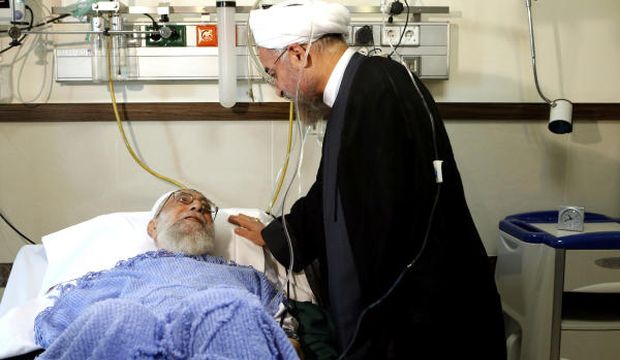
In this picture released by an official website of the office of the Iranian supreme leader, President Hassan Rouhani (R) visits Supreme Leader Ayatollah Ali Khamenei after his surgery in a hospital in Tehran, Iran, on Monday, September 8, 2014. (AP Photo/Office of the Iranian Supreme Leader)
London, Asharq Al-Awsat—Iran’s Supreme Leader Ayatollah Ali Khamenei underwent prostate surgery on Monday, according to official reports. Although the operation was described as “routine,” and was reported to have been successfully completed in less than 30 minutes. The announcement has fueled speculation among political commentators at home and abroad about his health and the identity of a possible successor.
Iranian state TV broadcast a short interview with the 75-year-old cleric on Monday morning, apparently only minutes before he was operated on. The release of the news of his hospitalization was accompanied by the release of photos on Khamenei’s official website showing him lying in bed after the operation, receiving visits from senior officials including President Hassan Rouhani.
The release of the photos and the announcement of his treatment was a rare event, with information about Khamenei and the state of his health usually carefully guarded. Rumors about Khamenei’s health have circulated for over a decade, including claims that he was suffering from prostate cancer. The last time information on Khamenei’s health was released by officials was in 1991—two years after he was appointed to succeed Ayatollah Ruhollah Khomeini—when he developed symptoms of a stomach illness which also required surgery.
Khamenei’s treatment led some to suggest the supreme leader had been diagnosed with an aggressive form of prostate cancer. According to the rumors, this led his medical team to recommend the organ’s partial removal to delay the disease’s progress, given the health risks of a more radical approach.
The reports also follow claims from Mehdi Hashemi Rafsanjani, the son of influential former president Akbar Hashemi Rafsanjani, who said in a rare interview with Iranian opposition media in London two years ago that Khamenei was suffering from prostate cancer.
Reza Qasemian, an Iranian cancer expert based in Washington DC, told Radio Farda: “Given the very limited medical information available about Khamenei’s condition it is impossible to reach a conclusion, but he confirms that there is no doubt that the prostate had enlarged, hence it had to be removed.”
Among the high-ranking officials visiting Khamenei after his operation, President Rouhani and his ally Akbar Hashemi Rafsanjani, who is chairman of the influential Expediency Council, were first to appear at the leader’s bedside.
Although relatively youthful by Iranian standards—his predecessor was 77 years old on taking office—Khamenei’s illness has focused attention on the topic of his possible successor, and if the Islamic Republic’s system of government would be able to survive the power struggle that could potentially be launched if Khamenei dies or becomes incapacitated.
In the event of his death, a group known as the Assembly of Experts, comprised of 80 elected clerics, will appoint the new leader, according to Article 107 of the country’s constitution. The current chairman, Ayatollah Mohammad-Reza Mahdavi Kani, recently fell into a coma following a stroke, leaving a vacuum at the head of the council. Ayatollah Mahmoud Hashemi Shahroudi, the former chief justice and head of Iraq’s Islamic Revolutionary Council during the 1980s, is acting in his stead.
If Khamenei is incapacitated by illness, the Iranian constitution states that a three-member council consisting of the president, the chief justice, and a clerical member of the Guardian Council will assume the authorities and duties of the leader. A cleric from the Guardian Council would be selected by the vote of another body, the Expediency Council.
Some critical decisions made by this temporary council would also have to be approved by a three-quarters majority of the Expediency Council, chaired by Akbar Hashemi Rafsanjani.

Trackbacks/Pingbacks